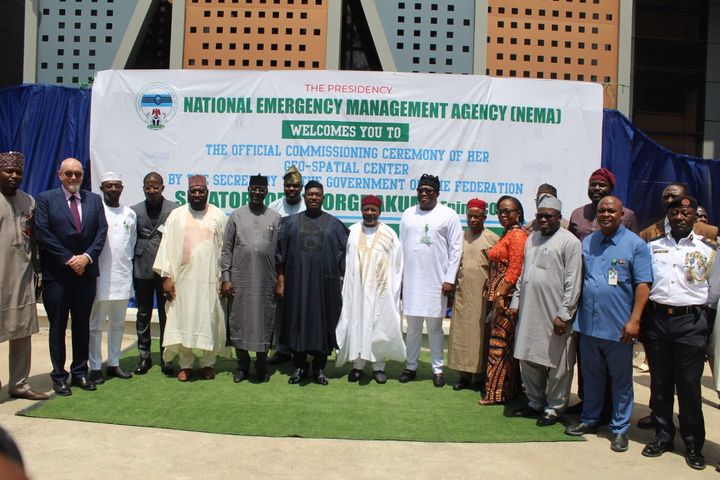
By Abdulkadir Ibrahim
In a world prone to various natural and man-made disasters, the role of effective disaster management cannot be overstated. For Nigeria, a country susceptible to a range of hazards such as floods, droughts, and epidemics, the recent commissioning of the National Emergency Management Agency (NEMA) Geospatial Center by the Secretary of The Government of the Federation Senator George Akume under the leadership of the Director General Mustapha Habib Ahmed marks a significant step forward in fortifying the nation’s disaster response capabilities.
The NEMA Geospatial Center was established with the vision to leverage cutting-edge geospatial technologies in disaster management.
This state-of-the-art center integrates Geographic Information System (GIS), remote sensing, and satellite imagery to enhance situational awareness, preparedness, and response strategies.
Key Features and Capabilities:
1. **Real-time Monitoring:** The Geospatial Center provides real-time monitoring of potential disaster hotspots.
Through satellite imagery and GIS mapping, authorities can identify vulnerable areas and allocate resources proactively, minimizing response time during emergencies.
2. **Risk Assessment and Mitigation:** The center facilitates comprehensive risk assessments, allowing authorities to identify potential hazards and vulnerabilities.
This data-driven approach enables the formulation of targeted mitigation strategies to reduce the impact of disasters on communities.
3. **Coordination and Communication:** Effective disaster management relies on seamless coordination and communication.
The Geospatial Center acts as a hub for collating and disseminating critical information to relevant stakeholders, fostering a more coordinated and efficient response to emergencies.
4. **Resource Allocation:** With geospatial data, decision-makers can optimize resource allocation by directing aid and relief efforts to areas most in need. This ensures a more equitable distribution of resources during crises.
5. **Post-Disaster Recovery Planning:** Beyond immediate response, the Geospatial Center aids in long-term recovery planning.
By analyzing the extent of damage and mapping affected areas, authorities can formulate sustainable rebuilding strategies and allocate resources strategically for reconstruction efforts.
The Socio-Economic Impact:
The establishment of the NEMA Geospatial Center is not just a technological milestone; it carries significant socio-economic implications for Nigeria.
By enhancing disaster resilience, the center contributes to safeguarding lives, protecting infrastructure, and preserving livelihoods.
This, in turn, fosters economic stability by minimizing the socio-economic disruptions caused by disasters.
While the NEMA Geospatial Center represents a commendable stride in disaster management, challenges such as data security, infrastructure maintenance, and continuous skill development must be addressed.
Furthermore, ongoing collaboration with international partners and leveraging emerging technologies will be essential to staying at the forefront of disaster management innovation.
The commissioning of the NEMA Geospatial Center heralds a new era in Nigeria’s approach to disaster management.
By harnessing the power of geospatial technologies, the nation is better equipped to face the complexities of an unpredictable world.
As the center evolves and adapts to emerging challenges, it stands as a testament to Nigeria’s commitment to safeguarding its citizens and building a resilient and disaster-ready nation.
Press unit
NEMA Headquarters Abuja

